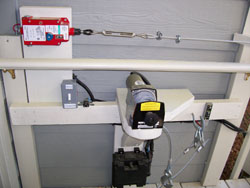Designers: Daron Gunn, Audrey Burke and Sophie Strike
Supervising Professor: Larry Bohs
 INTRODUCTION
INTRODUCTION
Our client, a manual wheelchair user, would like to preserve her independent lifestyle in the event of an upper body injury. The goal of this project was to develop a device to help her ascend the ramp into her home more easily. The Wheelchair Ramp Power Assist pulls her up the ramp using a winch motor and a steel cable attached temporarily to her wheelchair. A remote control, held by the client, actuates the winch, and a pull-cord safety switch mounted to the ramp rail stops the system in an emergency. This system provides powered assistance for our client, but still allows her to ascend the ramp manually.
SUMMARY OF IMPACT
The client has been using the device regularly, more often in cold and inclement weather. She commented, “The Ramp Assist has become a useful tool in my routine. It saves energy and stress on my shoulders. I used it daily during the winter and use it a few times a week in the spring. The Ramp Assist has given me an added and unexpected factor of safety and independence especially in winter weather. The surface of the ramp ices over so on occasions when there was ice or snow, the Ramp Assist enabled me to get up without help. I could barely get up without it because my wheelchair tires would not grip on the ice or snow.”
TECHNICAL DESCRIPTION
The Wheelchair Ramp Power Assist (Figure 1) uses a 12V DC winch (Superwinch T1500) with a 40′ steel cable that ends with a large spring hook. A second piece of steel cable, with spring hooks attached to each end, loops through this hook. The client attaches her chair to the system by attaching these two hooks to each armrest on her wheelchair, as shown in Figure 2.
The client controls the winch using a wireless remote system (Superwinch). The remote has two buttons, one for winding and one for unwinding the cable. The client must continually press the buttons on the remote to operate the winch. This feature provides a safety mechanism, because if the client drops the remote, the winch will automatically stop. The wireless receiver is housed in a weatherproof box and mounted at the top of the client’s ramp near the winch.
The winch is powered by a 12V deep-cycle lead-acid battery, necessary because no outside power outlets exist at the client’s condominium. The battery must be charged approximately every four weeks. A battery charger (Schumaker, Monroe, NC), battery tester (Motormite), and extension cord are provided. The battery and charger are stored out of sight under the ramp. The battery tester is mounted at eye level at the top of the ramp, alerting the client with an LED light when the battery needs charging. To charge the battery, the client attaches the extension cord from an outlet just inside her front door to the male AC plug securely mounted near the winch, and leaves it overnight. A double throw toggle switch with two positions, “winch” and “charge”, guarantees that the winch cannot be used while the battery is charging, and vice versa.
 An industrial single pull stop switch (Allied Electric, Southfield, MI) provides an additional safety mechanism. The pull stop connects to a cable that runs down the length of the ramp. Should the winch continue winding when the client releases the remote button, the client can pull the cable, cutting power to the winch and stopping all movement. Then the client can then unhook herself and ascend the ramp manually.
An industrial single pull stop switch (Allied Electric, Southfield, MI) provides an additional safety mechanism. The pull stop connects to a cable that runs down the length of the ramp. Should the winch continue winding when the client releases the remote button, the client can pull the cable, cutting power to the winch and stopping all movement. Then the client can then unhook herself and ascend the ramp manually.
The winch cable is taken to the bottom of the ramp by reversing the winch direction while the client descends. Descending in this manner takes longer than descending freely, but she has improved her speed and comfort with practice. Cost of parts was $840.